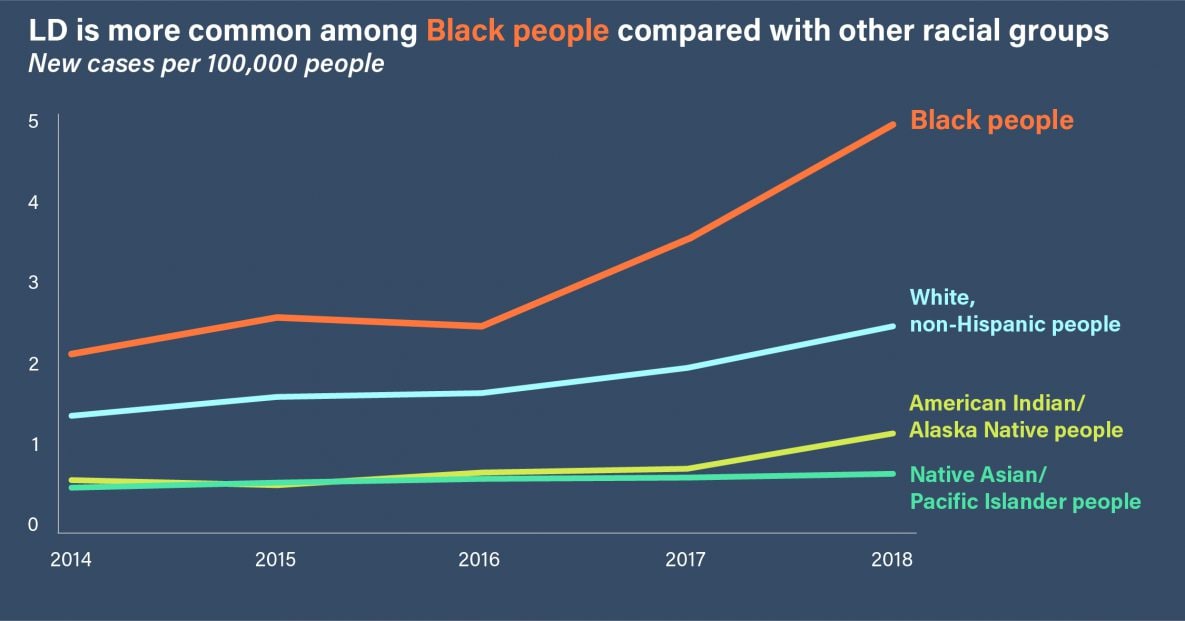Racial Disparities and Legionnaires’ Disease
Learn about drivers of health disparities and explore what they mean for future research and practice.

Data from CDC’s National Notifiable Diseases Surveillance System as published in the scientific articleexternal icon this summary is based on.
Legionnaires’ disease (LD) is increasing in the United States, and Black people and people of lower income have higher rates of it. We reviewed articles on health disparities and LD and other respiratory-related diseases. We then grouped the findings by five social determinants of health. Social determinants of health are the conditions in which people are born, grow, live, work, worship, and age that can affect their health and quality of life. Our goal was to look at causes of these health disparities so future research and interventions can help prevent new cases of LD.
New cases of LD are at least 60% higher among Black people than among White, non-Hispanic people. For example, in 2018, new cases were more than twice as high among Black people than among White, non-Hispanic people (4.87 cases compared with 2.37 cases per 100,000 people).
We explored social determinants of health underlying these health disparities to help guide future research and interventions. We used the five social determinants of health outlined in Healthy People 2030, a national plan for addressing public health challenges. Those included 1) economic stability, 2) education, 3) health and health care, 4) neighborhood and built environment, and 5) social and community context:
- People living in poverty had the highest rate of new LD cases.
- Job type also affects LD risk. People working in hazardous or service industries — including transportation, repair, protective services, cleaning, and construction — were at increased risk.
- People with less education were more likely to have LD and more likely to have pneumonia.
- New cases of LD were elevated among people with certain conditions, including diabetes and pneumonia.
- New cases of LD were elevated among people who lived in areas with a higher percentage of vacant homes, rented homes, and homes built before 1950.
- New cases were also elevated among people who lived near construction sites and cooling towers.
- No studies measured social and community context factors such as stress, discrimination, or social interactions that might affect rates of LD.
- Future researchers can help fill gaps in information relating to this social determinant of health.
Researchers can help fill knowledge gaps related to built environment factors such as housing, drinking water systems, and pollutant exposures. Such research can show how repeated exposure to environmental risks adds to LD health disparities. Certain communities are more likely to have vacant buildings with poorly maintained water systems, older housing with deteriorating plumbing, and declining drinking water infrastructure—conditions that create the environment for Legionella growth in pipes. Research in this area can help identify interventions to address these conditions.
Environmental health programs and researchers can correlate data on social determinants of health with mapped locations from LD surveillance data (see text box). Our findings underscore the importance of examining data in the context of social determinants of health related to LD.
Environmental health programs and researchers can offer assistance to healthcare organizations and stakeholders working to address poor housing quality, air pollution, and conditions that disproportionately affect people with lower incomes and people from racial and ethnic minority groups.
Some data sources that link environmental and socioeconomic variables
- County Health Rankings and Roadmapsexternal icon (Robert Wood Johnson Foundation)
- Environmental Public Health Tracking Network (CDC)
- Social Vulnerability Index (CDC/ATSDR)
- Read the scientific article on which this plain language summary is based: Racial disparities in incidence of Legionnaires’ disease and social determinants of health: A narrative review.external icon
- Explore CDC’s Toolkit on Developing a Water Management Program to Reduce Legionella Growth and Spread in Buildings.
- Discover CDC’s new Toolkit for Controlling Legionella in Common Sources of Exposure.
- Take Preventing Legionnaires’ Disease: A Training on Legionella Water Management Programs (PreventLD Training).
- Find more LD Resources.
- Learn more about Racism and Health.